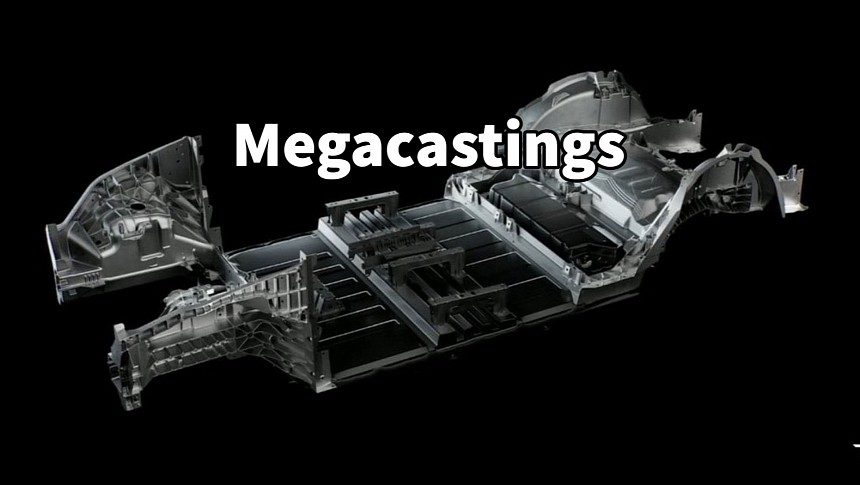Tesla was the first carmaker to use die-casting in vehicle manufacturing, replacing many components in the car's structure with a single "megacasting." Other carmakers are already following suit. Geely's Zeekr brand is the latest to announce that it would adopt megacastings for its Zeekr 009 MPV.
Tesla has always been a disruptor in the auto industry, not least because it was the first startup to succeed in what was a hermetic industry. It was also the first carmaker to prove that electric vehicles can be profitable and is probably the only one to make money from EVs. Still, Tesla's contribution to the auto industry is more important than that. The EV maker has reinvented car manufacturing by designing a more efficient factory layout.
Tesla's iconic gigafactories are unlike anything the auto industry has ever seen. The unique layout allows for building up to two million vehicles per year in a much smaller footprint. Typical car manufacturing plants are built for 350,000-400,000 vehicles per year. Tesla's gigafactories also allow the components to be delivered to specific points on the production line, minimizing time spent in transit.
Still, the most significant innovation so far is using die-casting in car body manufacturing. Tesla Model Y uses two so-called megacastings replacing front and rear structures, both attached to the structural battery pack. This eliminates hundreds of individual components, cuts welding points, and simplifies the production line tremendously. Megacastings don't need thermal treatment and offer structural rigidity and safety advantages.
If you're wondering why other carmakers haven't considered using die-casting in their vehicles before, it's because megacastings are not easy. They require gigantic presses that Tesla and Italian company IDRA developed. Currently, the biggest die-casting machines in the world are the 9,000-ton Giga Presses that Tesla uses for the Cybertruck production. Still, Tesla's success is a great incentive for other companies to follow the EV maker.
The latest to announce the use of megacastings in its vehicles is Geely's Zeekr. The Chinese carmaker uses aluminum die-cast to make a large underbody section of the Zeekr 009 minivan, which started sales this year. Geely's subsidiary says the technique eliminates 800 welding points, cuts defects, and makes the cars lighter and more rigid. Geely will use megacastings for more models in the future, including for other brands in its portfolio, such as Volvo. Zeekr uses 7,200-ton die-casting machines supplied by LK Machinery, the Chinese company that happens to own IDRA.
Previously, Chinese companies such as NIO and XPeng have explored using megacastings. Mercedes-Benz and Volkswagen are also contemplating using die-casting, while GM is already using them for the Cadillac Celestiq, but in a different way. GM is concerned with the repairability of megacastings, which might need replacement even for moderate shocks caused by a fender-bender. Because of this, GM uses six smaller castings for Celestiq's underbody frame, bonded and spot-welded into a single floor pan.
Tesla's relentless innovation in car manufacturing has not stopped even after megacastings and structural battery packs. During Investor Day, Tesla unveiled a new manufacturing technique called "unboxed vehicle." This implies dividing vehicles into several sections that people can work on concurrently. They are joined during final assembly, with the advantage of speeding up the assembly process and cutting costs even further. The upcoming Mexican gigafactory will be the first to use the new manufacturing process to produce the next-gen Tesla vehicle.
Tesla's iconic gigafactories are unlike anything the auto industry has ever seen. The unique layout allows for building up to two million vehicles per year in a much smaller footprint. Typical car manufacturing plants are built for 350,000-400,000 vehicles per year. Tesla's gigafactories also allow the components to be delivered to specific points on the production line, minimizing time spent in transit.
Still, the most significant innovation so far is using die-casting in car body manufacturing. Tesla Model Y uses two so-called megacastings replacing front and rear structures, both attached to the structural battery pack. This eliminates hundreds of individual components, cuts welding points, and simplifies the production line tremendously. Megacastings don't need thermal treatment and offer structural rigidity and safety advantages.
If you're wondering why other carmakers haven't considered using die-casting in their vehicles before, it's because megacastings are not easy. They require gigantic presses that Tesla and Italian company IDRA developed. Currently, the biggest die-casting machines in the world are the 9,000-ton Giga Presses that Tesla uses for the Cybertruck production. Still, Tesla's success is a great incentive for other companies to follow the EV maker.
The latest to announce the use of megacastings in its vehicles is Geely's Zeekr. The Chinese carmaker uses aluminum die-cast to make a large underbody section of the Zeekr 009 minivan, which started sales this year. Geely's subsidiary says the technique eliminates 800 welding points, cuts defects, and makes the cars lighter and more rigid. Geely will use megacastings for more models in the future, including for other brands in its portfolio, such as Volvo. Zeekr uses 7,200-ton die-casting machines supplied by LK Machinery, the Chinese company that happens to own IDRA.
Previously, Chinese companies such as NIO and XPeng have explored using megacastings. Mercedes-Benz and Volkswagen are also contemplating using die-casting, while GM is already using them for the Cadillac Celestiq, but in a different way. GM is concerned with the repairability of megacastings, which might need replacement even for moderate shocks caused by a fender-bender. Because of this, GM uses six smaller castings for Celestiq's underbody frame, bonded and spot-welded into a single floor pan.
Tesla's relentless innovation in car manufacturing has not stopped even after megacastings and structural battery packs. During Investor Day, Tesla unveiled a new manufacturing technique called "unboxed vehicle." This implies dividing vehicles into several sections that people can work on concurrently. They are joined during final assembly, with the advantage of speeding up the assembly process and cutting costs even further. The upcoming Mexican gigafactory will be the first to use the new manufacturing process to produce the next-gen Tesla vehicle.









